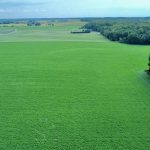A real estate listing that asks $6.8 million for more than 35,000 acres in southwestern Saskatchewan has set tongues wagging.
It’s the largest piece of land ever listed by Regina-based Lane Realty Corp. and the highest price, said listing agent Garth Hendry.
The price reflects the parcel’s unique characteristics, he said.
It includes 35,740 acres in the Val Marie area, adjacent to Grasslands National Park. Some of the land is in the middle of the park.
Hendry describes it as distinctive, rugged, wide open and like stepping straight into a movie.
Read Also

Forecast leans toward cooling trend
July saw below average temperatures, August came in with near to slightly above average temperatures and September built on this warming trend with well above average temperatures for the month.
“It’s almost virgin land,” Hendry said. “It’s a hard thing to put a price on.”
However, just 1,600 acres of the parcel are deeded; the remainder is provincial crown lease. Most of it is grass, on which the current lessee, Frenchman Valley Cattle Co., is running 750 cow-calf pairs.
Al Syhlonyk, director of Saskatchewan Agriculture’s lands branch, said crown leases are often involved in real estate transactions because some of the leases go back nearly 100 years and the lands have become an integral part of a ranching operation.
“We have a policy in place which allows the sale,” he said.
The policy requires the purchaser to acquire both the deeded and lease land so the entire unit continues to function as a farm or ranch.
And, the seller has to apply to transfer the lease to the incoming purchaser. That purchaser must show that he or she is eligible to take on the lease by meeting criteria set by the province.
The agriculture department would then analyze the deal and make a recommendation about whether the lease can be transferred.
The provincial cabinet also plays a role.
“Under the Provincial Lands Act regulations, any lease in excess of 25,000 acres needs to be approved by order-in-council,” Syhlonyk said.
There are less than two dozen leases that large, he said.
In essence, the sale is only for the deeded land and any improvements the seller has made on the lease land, such as dugouts or fences.
The purchaser who takes on the lease will still pay lease fees.
Hendry said the conditions are nothing new and well understood.
He said there has been some good interest in the land, which has been listed for about three months.
“We wouldn’t expect as much interest in as huge a block,” he said.
But he also doesn’t expect that the eventual buyer will simply keep ranching.
Hendry said grazing is only one use for the land that is being advertised as multi-use and an outdoor opportunity. Potential buyers include those who can be “innovative and creative in trying to widen their scope of revenue to be viable.”
People could run covered wagon treks and other tourism ventures, Hendry suggested, or even use the unique landscape to make movies.
There is also the possibility that the federal government could look at adding to the national park or that another conservation organization could step in.
Looking at just a straight cow-calf operation, the numbers don’t add up to profit, he said.
“That’s why we’re looking at other options.”















